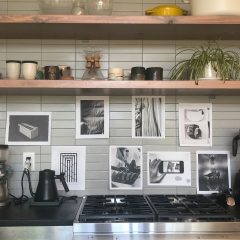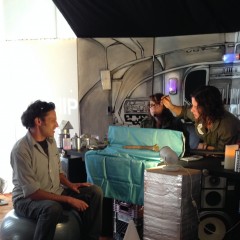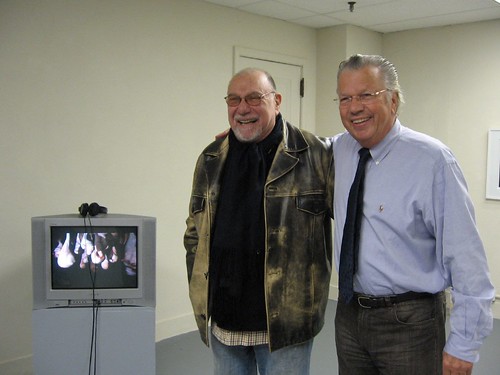
Osvaldo Romberg (left) and collector Lutz Teutloff at Slought Foundation, next to video In Bocca al Lupo, 2003, dvd by Patricia Piccinini, from the Teutloff Collection
We got an invitation to meet German collector Lutz Teutloff and his wife Hannelore at Slought Foundation. Teutloff has collected 1,000 pieces of video and photographs focused on the human body. About 35 pieces from the collection are on view at Slought until Feb. 9, in the show Switcher Sex. This is the collection’s debut in a public stage.
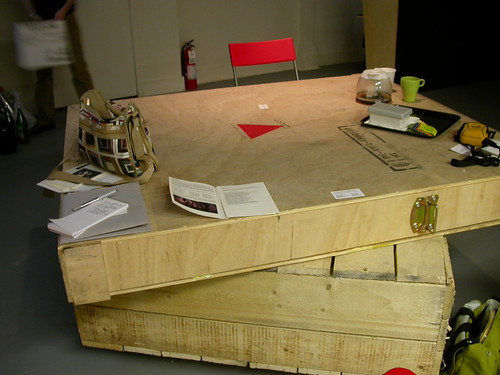
Teutloff Collection shipping crates at Slought put together like a table.
We sat at an ad hoc coffee table made up of two large packing crates stacked on top of each other. They are the crates that brought the Teutloff Collection show to Philadelphia from Bielefeld, Germany (near Hanover). We had coffee or tea in green Ikea mugs. Curator Osvaldo Romberg joined in the conversation, and gallery Director Aaron Levy also chimed in. It all felt very international.
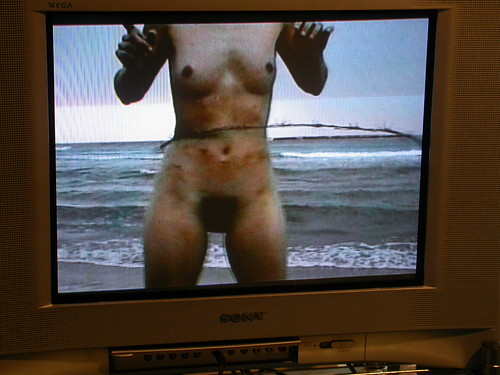
Sigalit Landau, Barbed Hula, 2003, DVD
Switcher Sex is a dynamic show filled with works that evoke the vulnerability of the body, from Sigalit Landau‘s barbed wire hula hoop tearing into the skin of a nude hula hooper to Dario Mitadieri‘s pile of dead bodies in a Beijing hospital after the Tienanmen Square massacre. The show deals with big human issues at play in the world–like gender identity, death and the varying definitions of beauty. It’s a harrowing show to look at, its light moments far outnumbered by ones of darkness and questions. It shows how artists use bodies to mirror contemporary society.
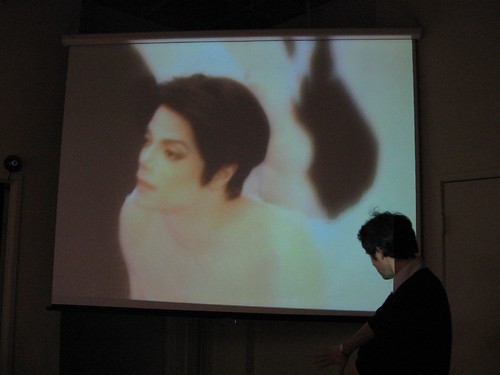
Una Szeemann, Thrill Me, 2004, DVD
We are sitting under a screeen on which is projected an hysterical video, Thrill Me, showing archival footage of Michael Jackson covering the time from when he was the tiny, smiley, bouncy singer of the Jackson 5 to his current incarnation as a weird androgynous freak. It’s by Una Szeemann. Someone says Szeemann’s father was influential activist curator Harold.
The conversation around the make-shift table meanders, and we can barely keep up with Lutz.
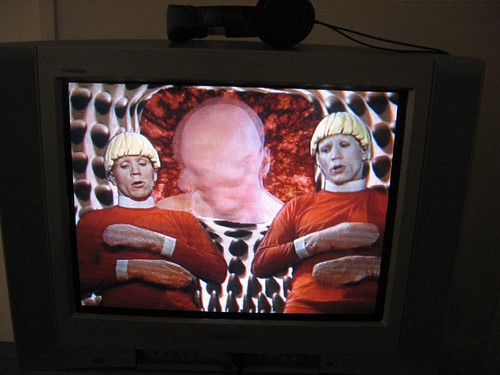
Bjorn Melhus, No Sunshine, 1977, DVD
Then Levy puts a different CD in to show us a Tracey Emin video, Sometimes the dress is worth more money than the money. Her video, which shows on alternate days with the Szeemann video, uses music of Clint Eastwood spaghetti westerns as the soundtrack for a bride in a Western landscape running around trying to escape something or someone. Her wedding gown is festooned with dollar bills. The influence of music videos on the Emin and Szeemann work is obvious, as well as on No Sunshine, a terrific 1997 video by Bjorn Melhus that looks kind of like a skit from Saturday Night Live. The quick cutting and music references are a relief from the more leaden, but ground-breaking, morphing in Peter Weibel’s 1972 Switcher Sex video, which gave its name to the exhibit.
Artblog. How do you know each other (Oswaldo and Teutloff)?
Osvaldo: I know him from the 1980s. He has a great collection. He’s ambitious. He goes after what he wants and he’s faithful to the art he buys.
Artblog: And you and Oswaldo, how did you meet?
Lutz: We met at Andy Warhol‘s birthday party in Cologne.
Immediately thereafter, Lutz took a look at Osvaldo’s work at a Cologne gallery, bought out the show, and used the purchase to open his own gallery, Gallery Teutloff Bielefeld/Cologne in 1989. Lutz also gave Osvaldo a show at the Frankford Book Fair.
Lutz: Twenty-five percent to one third of the collection is totally unknown (artists) and I put them next to well known artists, famous names, and they resonate, have a conversation. This [2007] Documenta had 50 percent unknowns. It was bad (i.e. too many unknowns–or not the right unknowns).
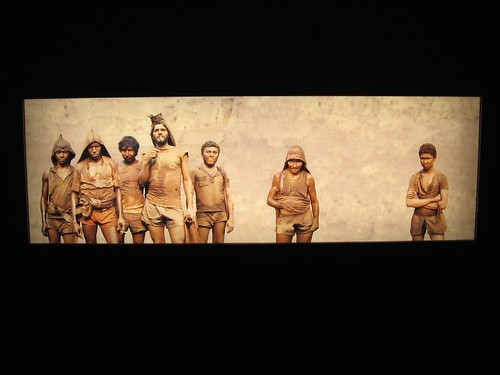
Alfredo Jaar, Gold in the Morning 1985, 1985, photograph in light box
Artblog: Do you have a museum? How did your collection get here?
Lutz: All of a sudden Osvaldo says I want to see your collection. I said come. I was not prepared because I’m still collecting. I’m thinking 2009 was the earliest to come out with the collection.
Artblog: How big is the collection?
Lutz: One thousand pieces in all.
Osvaldo: When I saw it I said let’s show the collection….we have from the aesthetic to the erotic…the hermaphrodite, from the ancient to more current, Serrano, Aphrodite–no moral stupidity. …The collection gives to a curator possibilities.
Aartblog: How did you get started with art? Did you have an art education?
Lutz: I started as a gallerist—with Oswaldo’s art. I came late to it. At 50. I sold my company. It was a garment business. I got tired after 35 years. When I started [in art] I thought, Only nice people, only serious people are working in art …but in 20 years I learned a little. I learned the art market is very tricky.
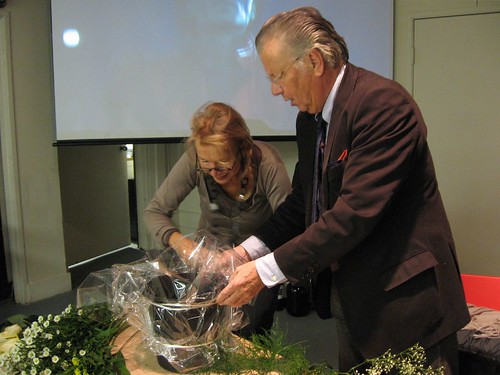
The Teutloffs decorate for a reception at Slought Gallery.
Hannelore: I made wonderful (embroidery) designs. After eight weeks, we found our styles in New York. That’s the danger of doing business in China.
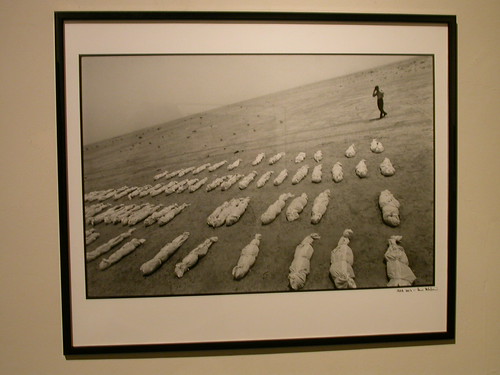
Iraque 2003, silver gelatin print, Dario Mitidieri. A sample of the type of documentary photography Mitidieri does in some of the world’s hot spots of war and militarism. This piece is in the Slought show.
At this point Lutz leaps up and grabs a piece from the wall in the other room and brings it in…we have to see it– Dario Mitidieri’s Beijing 1989. It’s a pile of bodies from Tiananmen Square (dead bodies). It’s photo journalistic, like WeeGee in China.
Lutz: [Mitadieri does] very political work. This is absolutely the truth. The bodies were brought into the hospital and piled up.
Hannelore: It was risky, taking these pictures.
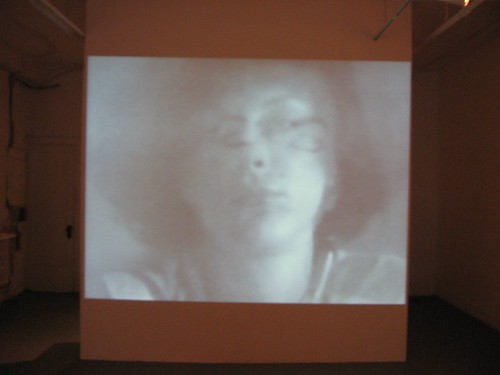
Peter Weibel, Switcher Sex, 1972, DVD
Artblog: A lot of your work is videos. What do you think of You Tube?
Lutz: I’m a little scared of all these large companies…in the beginning video was not accepted in art world. If you see what Peter Weibel has done with the morphing idea in Switcher Sex, that’s over 30 years ago. Everybody was thinking it’s a kind of schnick schnack—bricolage–with no meaning. Now it’s all over and now it’s really art.
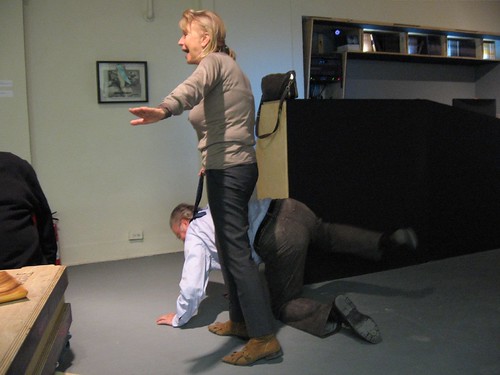
The Teutloffs do their impression of Valie Export’s piece, with Peter Weibel.
Shortly after some discussion about Israeli artist Sigalit Landau and her use of her body as a political weapon, someone mentions that Peter Weibel is coming to Slought Feb. 7. We also talk about Valie Export, whose piece Der Schrei is in the show (not shown). We tell them about how Valie Export came here for a show at the Galleries at Moore and how wonderful it was to see her at a panel discussion on activist art. Lutz talks about how Weibel was Export’s companion and how they did performance actions in Vienna together.
Suddenly, Lutz gets down on all fours and Hannelore grabs his necktie like a chain to demonstrate how in one performance Valie Export walked Weibel like a dog down the streets of Vienna, with the naked Weibel occasionally lifting his leg to pee.
By now, Lutz and Hannelore have returned to the table.
Artblog: What do you think of China? Chinese art?
Lutz: I’m familiar with China. The art world is coming up. There’s 1.3 billion people. Shenzhen is building a huge art complex. It’s a city without any art or any culture. When I was there doing my embroidery (business), Shenzhen went from 200,000 to 17 million people in 25 years. But there’s nobody there who knows art. The government says (they’ll build a) 900,000 sq. ft. facility. Shenzhen is 30 miles from Hong Kong.
Artblog: Is this show representative of your collection?
Lutz: No. This is Osvaldo’s show.
Artblog: What art do you live with at home?
Lutz: At home we have Chinese art—ancient Ming vases.
Artblog: Where do you house the collection?
Lutz: At a little warehouse.
Artblog: When you buy a video piece how do you upgrade it when the technology moves forward (VHS to DVD etc). Does the artist do it for you?
Lutz: The collector has to do it.
Artblog: You Tube…what do you think of it; how has it affected you?
Osvaldo: I like the idea of art is for everyone but …Suddenly, the individual has disappeared and everybody takes from everybody. I like democracy, but I like to maintain individualism. It’s promiscuity versus democracy. We live with this tragedy, lately.
Lutz: You can’t (stop You Tube)
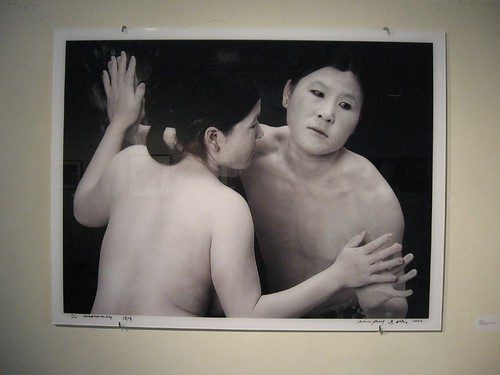
Artblog: Are you buying Chinese art?
Lutz: Chi Peng. I’m going to China. I met Ai Weiwei in his studio.
Artblog: Is that what you like to do, bypass the secondary markets and sources?
Lutz: I can’t go to the secondary market. It’s too high, very expensive, no way. It’s so inflated, it must come down. Landau cost 3,000 euros when I bought it. Now it’s 20,000–it went to MoMA. I buy only in the primary market. I make studio visits.
Artblog: Do you go to the art fairs? Which ones do you like best?
Lutz: Art Basel and Art Basel Miami. They’re better than Art in the Armory. In Miami, the layout was crazy, 24 fairs around Basel; it’s destroying the art scene.
Hannelore: It’s no longer an art fair. It’s shopping.
Artblog: Do you sell things from your collection?
Lutz: If I don’t like it anymore I sell it but what’s best is seeing the unknown (artists). That excites me.
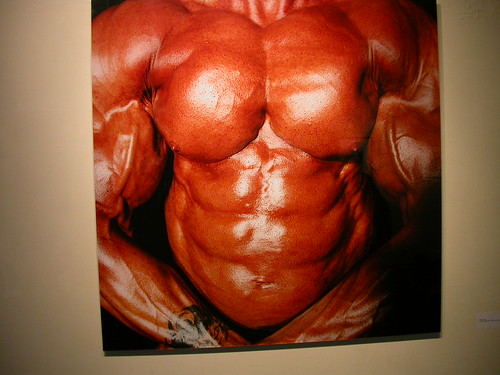
Brian Finke, Bodybuilding #17, 2004. color print
Artblog: How do you get to the unknowns?
Hannelore: Books. Catalogs piled up next to the bed. He looks at books all night long. I say come to bed and he says I have to read this. That’s daily life.
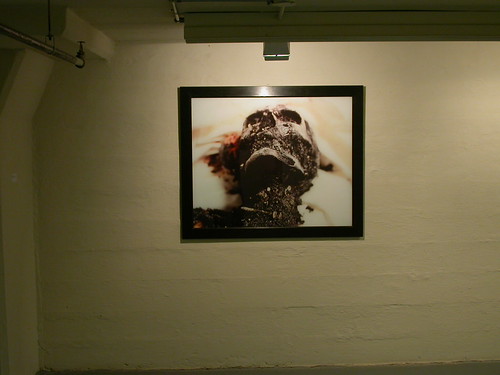
Andres Serrano,The Morgue, (Burnt to Death) 1992. cibacrome
Artblog: What excites you?
Lutz: The older I get the more political I get. …The first communication [to the world by the Teutloff Collection] appears here in Philadelphia. Now with Osvaldo’s show, it’s a start.
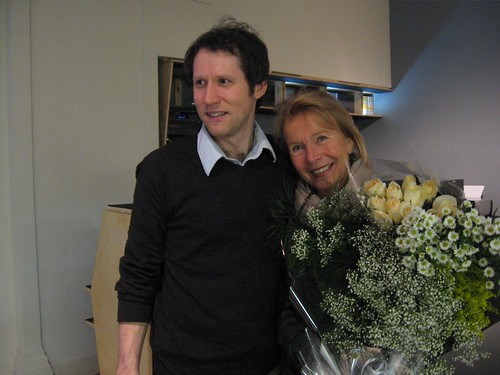
Slought Foundation Director Aaron Levy with Hannelore Teutloff and some flowers she bought to decorate the gallery.
Artblog: How about future shows?
Osvaldo: He’s preparing a good catalog. It will take time. I hope to travel the show. Three other museums are interested.
Lutz: Now it’s like a snowball. Aaron taught me of the deal between this city and that city and there’s money (in traveling shows). It’s different than Europe. In Europe, museums get money from the state, but it’s getting less.
I feel there’s more people engaged with their money, etc. here (America) than in Europe (meaning more collectors, more people who go to museums). Here, you have more of a public.
…The middle way is the best we say. Not whole government and not whole private. It must be 50-50, private and government together. Not 51-49. 50-50.Public and the government have to sit at the table to find the solution between the government and private sector.
Osvaldo: At Slought we sit here with no money, no salary, but we educate students. Prognosis is to create works, use art as a tool for changing society, engage everything.
Lutz: What’s going on with education in Germany–it’s going down, down, down. Education is what we need.
…In China, Ai Weiwei and other artists will build their own museum. This is new! The government will give 20 percent of the money for it—-otherwise they will lose face. It’s in the middle of nowhere.




